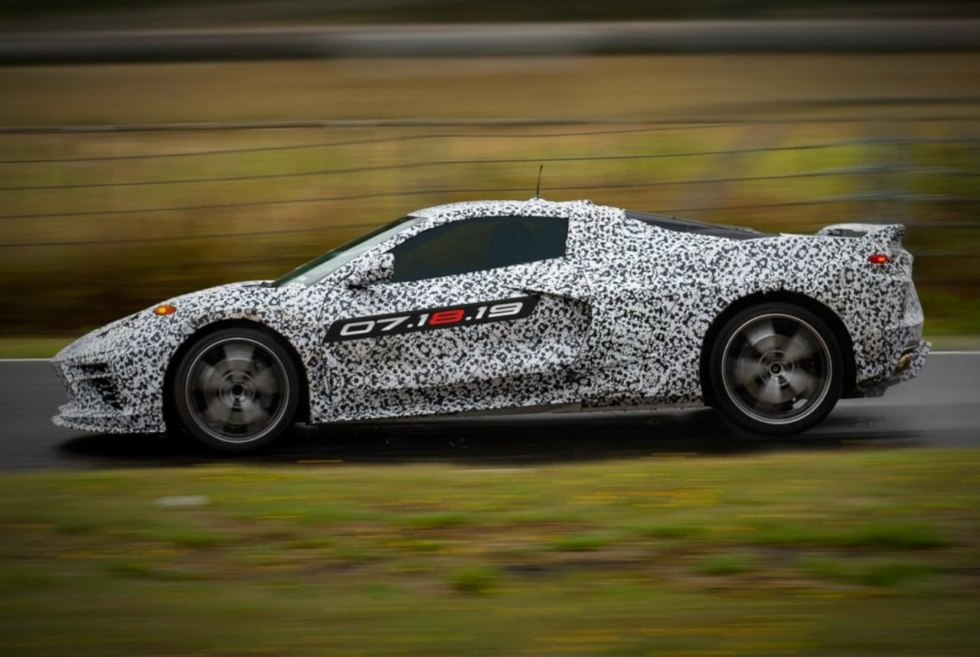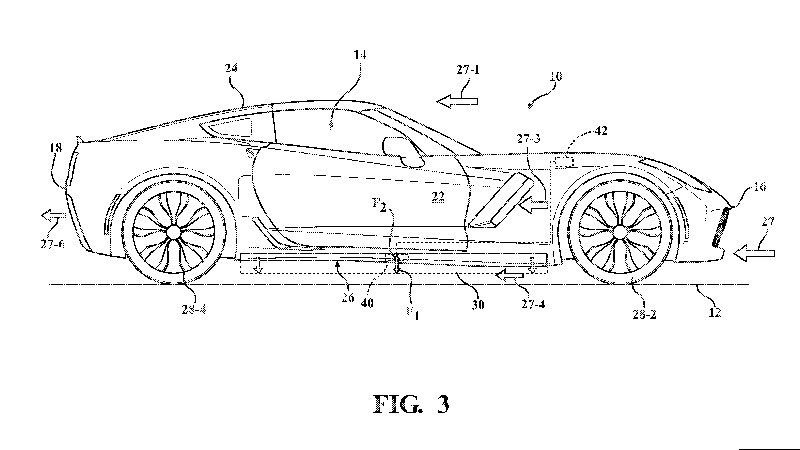We’ve taped up the windows and covered all available whiteboard and wall space with printouts, spy shots, sketches and maps of Bowling Green and Upstate New York. Hundreds of pushpins dot prominent points; miles of red strings connect them all. Data scientists call this link analysis. The cleaning people call it a nuisance.
The subject of our insanity? The upcoming mid-engine Corvette, the DOHC Corvette and, finally, the big-wing-toting Corvette ZR-1. Our deductive sleuthing tells us that all of these things are, finally, real. The evidence has been right in front of us for months. GM’s been hiding its plan in plain sight and we think we’ve cracked the code. Pore over our clues, follow along with our reasoning, and see if you agree with our conclusions.
(Note: We didn’t reach out to GM on any of this. They don’t comment on future vehicles, and we don’t want to waste their time.)
Dual Overhead Cam V8 Corvette? Really?
While the idea – and crummy renderings – of a mid-engine Corvette have sold a billion magazines and generated a trillion clicks, the transition to a DOHC layout should be the one getting everyone’s attention. Since almost the beginning, a big part of the Corvette’s DNA has been Chevy’s overhead valve, Small Block V8. And for good reason; these engines are compact, make great power across the rev band, can return exceptional fuel economy, and provide the reliability and inexpensive repairs that have kept the Corvette an everyman’s sports car for 60 years.
But those rods are pushing their last.
But those rods are pushing their last. We’re reaching the zenith of naturally-aspirated horsepower that any reasonable company would dare slap a warranty on (RIP, LS7), and Corvette buyers are repeat customers who will expect the next ‘Vette to top the C7’s 465 horsepower and 29 mpg. GM is one of the last holdouts on the naturally aspirated V8 and one of only two firms still offering it with pushrods. If GM wants to keep the V8, meet ever-stricter CAFE requirements, and continue to delight fans of the Corvette, something needs to change.
GM has done everything it can to keep the small block alive. Aluminum block and heads, direct injection, cylinder deactivation, variable valve timing. The next step is to either join the forced-induction party or admit the limitations of a two-valve motor and, literally, step up their cam game. The improved breathing and timing optimization afforded by four valves per cylinder and variable valve-timing-and-lift would get them there without a single person on the internet screaming about lag.
Oh, and let’s not forget that leaked document from late last year that confirmed a DOHC LT5 V8 for a Y chassis car.

Is it Doable?
The anti-DOHC naysayers will say that it requires a whole new engine block, and GM isn’t going to replace the Gen V engine so soon or spend the money on dual V8 lines. The argument also says overhead cams create a prohibitively tall engine for the available space. Let’s dispel both of these right now thanks to our friends at Mercury Marine. Yes, that Mercury Marine. The company that Chevy contracted to build the Lotus Engineering-designed DOHC LT-5 V8 motor that powered the legendary Corvette ZR-1 in the 1990s.

After teasing the concept for a few years, at the 2016 SEMA show Mercury Racing, the go-fast subdivision of Mercury Marine, launched its 750 horsepower, 8,000 rpm SB4 7.0 automotive crate motor. Based off of GM’s 7.0-liter LS7, the SB4 does away with GM’s valvetrain and swaps in their own 32-valve DOHC setup. On this engine, the new overhead cams are driven by a dual-belt system. A straightforward dual-roller timing chain setup is mounted on the front of the motor off the crank. We’ve reached out to Mercury Marine for clarification on what happens with the now-vacant in-block cam-hole and will update the story if we hear back. In Chevy’s case, it could cast a new block that plugs the oiling holes, but would need to reserve this tunnel for a prop shaft. The Corvette’s high-pressure fuel pump is driven off the back of the camshaft, so any changes to that would necessitate a fix for the pump, too.
Chevy’s LS3 stands a tidy 17.72 inches tall from the centerline of the crank to the top of the intake. Mercury Marine’s DOHC, measures 17.1 inches from the crank centerline to the top of the throttle bodies. Of course, there are some differences in the intake systems that could account for this difference, but the point remains that converting an LS motor from pushrod to DOHC does not add enough height to kill the project. Especially not when you’re talking about an engine that could return 600 horsepower without forced induction.
This is important for a couple of reasons. Remember that we’re not talking about a new engine for an all-new car here, folks. According to our leaked document above, this is going to be dropped sometime in 2018 while a new, C8 Corvette shouldn’t be expected until 2021 at the earliest. Not only does this new motor need to fit vertically, but it needs to fit in the same mounts as the current OHV motor. New hood? Easy. Potentially relocating the whole powertrain? Not so much. The above solution as proven by Mercury Marine solves both of these problems.
Is GM ready for this change?
As we’ve previously speculated, GM’s absurdly massive investment in a “paint shop” in Bowling Green is more than enough to launch another vehicle line, so swapping in a new motor won’t rock the boat. What we didn’t know then was that GM was about to put $295 million into its Tonawanda engine facility, where Corvette 6.2-liter V8s are made, to support “future engine production.” Steve Finch, Tonawanda’s plant manager, was quoted by the Buffalo News as saying that the new engines “would represent the next step for the plant’s existing ‘Generation V’ engine line.” Kathleen Dilworth, GM manufacturing director told the same paper, “They’re going into future vehicle products that we’re not prepared to announce yet, for competitive reasons.”
To put this $295 million number in perspective, the 2010 investment in Tonawanda to build the Gen V small-block was $400 million. That investment should be enough for a significant valvetrain upgrade, especially as this motor will also be spread across the pickup truck line.
Whaaaaat?
Alongside the nonsense “it won’t fit!” naysayers are the armchair MBAs who argue that GM is too focused on the bottom line and too obsessed with scale to do another expensive one-off engine line. These people are onto something. GM isn’t going to architect this updated motor just for the Corvette; we see it replacing all of the V8s.

The Gen V small block, introduced on the 2014 Corvette Stingray, found its way into the redesigned GMT K2XX trucks/full-size SUVs as the EcoTec3 in both 6.2 and 5.3-liter configurations. Any new development for the Corvette’s powertrain, besides the silly performance motors, needs to be flexible enough to do work across the whole GM portfolio.
Considering this, the timing is too perfect. For 2016, Silverado sales were down while nearly every other truck posted gains. Ford, specifically, is making gains with its lineup of efficient-according-to-the-EPA EcoBoost motors and aluminum bodies. GM needs to do something. A DOHC V8 would increase power and efficiency with minimal costs and no silly (and expensive) turbos. Finally, with the release of the new Chevy Tahoe RST, Cadillac and GMC need a hi-po engine offering to keep those profit machines rolling. We’re guessing we’ll see the first of these in 2018 as 2019 MY.
But first, we’ll see it in:

The big-wing, front-engine car (ZR-1)
To be fair, this is the weakest part of our argument, but stick with it. We’ve seen spy shots of this one (we’ll call it ZR-1 henceforth) a few times now, but haven’t gotten a good sense of what’s powering it. For a while, we were on the side of the fence that follows GM’s current pattern and assumed that the new ZR-1 would be the track-focused big-brother to the Z06. Think Chevy’s ACR.
That theory makes sense not only from a GM product strategy viewpoint, but would help explain why GM had rented out Mazda Raceway Laguna Seca for testing. Launching a new performance benchmark for your brand makes a bigger splash when you can say you’ve taken back the production car lap record from the Viper ACR. In this worldview, the ZR-1 doesn’t need more power or a new motor, it simply needs better tires, suspension and aero. Easy(ish). Trouble is, this totally reasonable plan doesn’t solve our problem with the leaked document showing a DOHC Corvette in 2018.
This only leaves one possibility: The ZR-1 introduces the DOHC motor back into the Corvette family with 650 naturally aspirated horsepower (a nice number that is more ponies than the ACR and more horsepower/liter than the Mustang Shelby GT350), an 8,000-rpm redline and the production-car track record at Laguna Seca.
For 2019, we bet that the DOHC motor trickles down into the rest of the Corvette lineup (excluding Z06) with 500 horsepower, a lower redline and 31 mpg highway fuel economy rating. And while we’re just spitballing here, don’t be surprised if the high-power DOHC engine wiggles into a Z28-style Camaro.
The mid-engine Corvette
So where does this leave the “Corvette” with the engine in the middle? Glad you asked!
There are obviously a number of hurdles for the mid-engine car to clear: 65 years of front-engined heritage, the everyman image, and the possible consumer resistance to a $150,000-plus Chevy. The mid-engine car needs to be a true halo product. A brand builder. And because it’s a Corvette (of sorts) it needs to punch above its weight from a performance perspective.

Which means that the mid-engine Corvette is going to have a souped-up version of the new family DOHC motor with a higher redline, higher peak horsepower and torque, and an inline electric motor.
Yeah. We think it’s gonna be a hybrid.
Where else can they go? Chevy’s already got a 650 horsepower Z06 in the stable, matching or barely beating that power figure for potentially double the price doesn’t work. AWD is cheating. (Besides, AWD could be reserved for a Cadillac version of this mid-engine flagship…the one that gets the 4.2-liter turbocharged V6. Think Audi R8 vs Lamborghini Gallardo here.) Supercharging could work, but it doesn’t provide enough model separation from the Z06, engine-wise. Not only does a hybrid powertrain system avoid any confusion/cross-shopping with the traditional Corvette, but it leapfrogs any domestic or foreign competition and launches the mid-engine Corvette smack into keyboard wars with the LaFerrari and McLaren P1. Especially if Chevy forgoes the obvious front axle e-motor solution and keeps the mid engine Corvette rear-wheel drive. This layout would fit with Corvette’s heritage and falls more in line with the driver-focused, tire-slaying nature of both Corvette customers and the engineers inside of Chevy.
Something like this integrated motor generator unit from Bosch which produces over 100 horsepower and nearly 300 torques would allow GM to tweak the gasoline motor for top-end power while letting the electric motor handle low-end torque fill. And that’s just an off-the-shelf solution; remember that Bosch was the electrification partner Porsche chose for the 918. If the two companies forge a serious partnership on this project, there’s no reason to doubt that the result would be one of the fastest, most technologically advanced supercars in the world.
Related Video:









